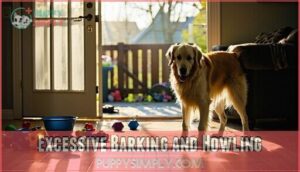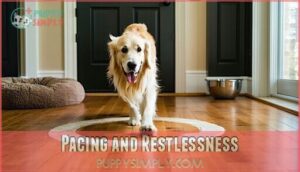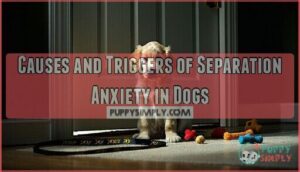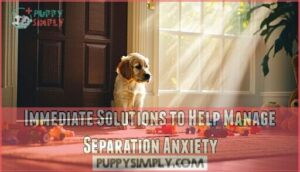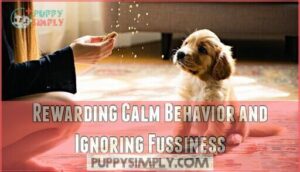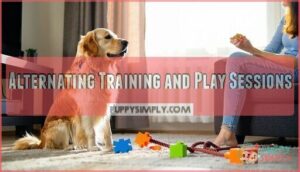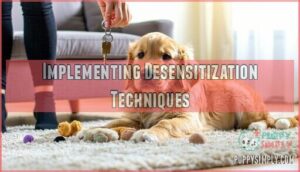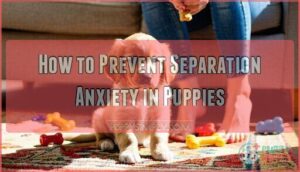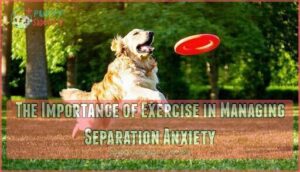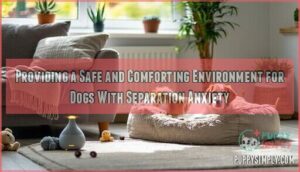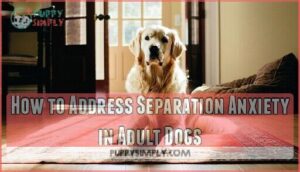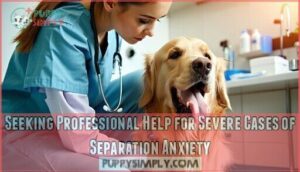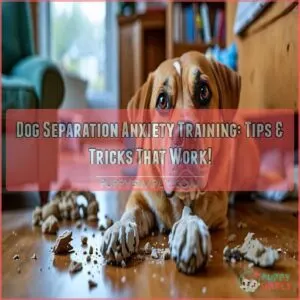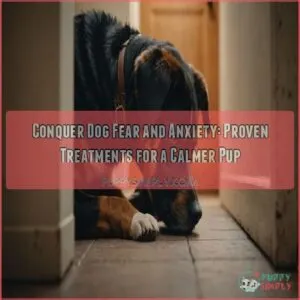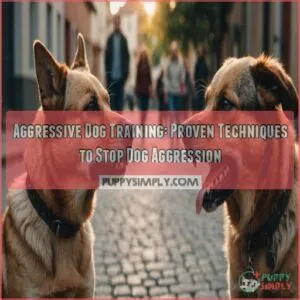This site is supported by our readers. We may earn a commission, at no cost to you, if you purchase through links.
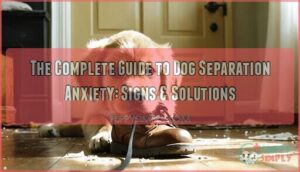 Dog separation anxiety affects millions of pets, causing destructive behaviors, excessive barking, and indoor accidents when you leave home.
Dog separation anxiety affects millions of pets, causing destructive behaviors, excessive barking, and indoor accidents when you leave home.
You’ll recognize the signs quickly – torn furniture, howling neighbors complain about, or finding "surprises" on your carpet.
This complete guide to dog separation anxiety breaks down proven solutions that actually work, from gradual desensitization training to creating safe spaces, you’ll discover practical techniques that transform anxious pups into confident companions.
The key isn’t avoiding departures but teaching your dog that being alone is safe and temporary.
These strategies address root causes, not just symptoms, setting both you and your furry friend up for success.
Table Of Contents
- Key Takeaways
- Understanding Separation Anxiety in Dogs
- Common Signs and Symptoms of Separation Anxiety in Dogs
- Causes and Triggers of Separation Anxiety in Dogs
- Immediate Solutions to Help Manage Separation Anxiety
- Reconditioning Protocol: Step-by-Step Guide to Overcoming Separation Anxiety
- How to Prevent Separation Anxiety in Puppies
- The Importance of Exercise in Managing Separation Anxiety
- Providing a Safe and Comforting Environment for Dogs With Separation Anxiety
- How to Address Separation Anxiety in Adult Dogs
- Seeking Professional Help for Severe Cases of Separation Anxiety
- Frequently Asked Questions (FAQs)
- How to build up leaving your dog alone?
- Should you let a dog with separation anxiety cry it out?
- Can older dogs develop separation anxiety suddenly?
- How long does separation anxiety treatment typically take?
- Are certain dog breeds more prone to separation anxiety?
- Can separation anxiety return after successful treatment?
- Should I get another dog to help with separation anxiety?
- Conclusion
Key Takeaways
- Start with gradual departures – Begin with just 30-second absences and slowly increase the time as your dog builds confidence, rather than rushing the process, which can worsen anxiety.
- Create positive associations with alone time – Use special toys, treats, and comfortable spaces that only appear when you leave, turning your departure into something your dog anticipates rather than dreads.
- Address root causes, not just symptoms – Focus on desensitization training and building independence rather than simply managing destructive behaviors or accidents after they occur.
- Exercise and mental stimulation are essential – A tired dog with a stimulated mind is calmer and more likely to rest peacefully when alone, making pre-departure activities crucial for success.
Understanding Separation Anxiety in Dogs
Dog separation anxiety isn’t just bad behavior—it’s a misunderstood phobia rooted in canine instincts.
Your dog’s pack mentality makes being alone feel dangerous, triggering genuine panic attacks. Defining anxiety properly helps you recognize the difference between attention-seeking and real fear.
Your dog’s frantic behavior isn’t defiance—it’s genuine fear that you won’t return.
Shelter adoption often increases risk due to past abandonment trauma. Aging dogs may develop new anxieties as their senses weaken.
Understanding these separation anxiety causes helps you address your dog’s legitimate distress with compassion rather than frustration. A key strategy involves positive reinforcement methods to build trust and reduce stress.
Common Signs and Symptoms of Separation Anxiety in Dogs
Recognizing the signs of separation anxiety in your dog is the first step toward helping them feel more comfortable when you’re away.
While every dog reacts differently, certain behaviors consistently signal distress rather than simple misbehavior.
Excessive Barking and Howling
When your dog’s barking echoes through the house like a fire alarm, you’re likely dealing with one of the most telling dog anxiety symptoms.
This vocalization isn’t just noise—it’s your pet’s distress signal when facing dog separation anxiety.
Understanding barking triggers helps you address the root cause.
Your dog might bark at:
- Departure cues – grabbing keys, putting on shoes, or reaching for your coat
- Environmental sounds – footsteps in hallways, car doors, or neighbors talking
- Time patterns – specific hours when they expect you home
Howling duration varies by breed predispositions.
Border Collies and German Shepherds often vocalize longer than calmer breeds.
Some dogs bark intermittently, while others maintain constant noise that leads to noise complaints from neighbors.
Different vocalization types signal varying anxiety levels.
Sharp, repetitive barking indicates panic, while low whining suggests mild distress.
Excessive barking anxiety requires dog anxiety treatment combining behavior modification with environmental changes.
Addressing these dog behavior problems starts with recognizing that your pet isn’t being stubborn—they’re genuinely scared and need your help.
Destructive Chewing and Digging
When dogs experience separation anxiety, they often channel their panic into destructive chewing and digging behaviors. Your furniture legs, shoes, and door frames become casualties of their distress.
Unlike playful puppy mischief, these dog anxiety symptoms target escape routes and comfort items.
Breed predisposition plays a role—working breeds like Border Collies need mental stimulation or they’ll create their own entertainment.
Root cause analysis reveals these aren’t random acts but purposeful attempts to cope with overwhelming emotions.
Redirecting behavior starts with understanding triggers. Provide appropriate chew toy options before leaving—rotating Kong toys stuffed with treats keeps dogs engaged.
For diggers, create a digging box solution using a sandbox filled with sand or dirt where they can channel this instinct safely.
Address destructive behavior anxiety by dog-proofing your space and offering alternatives. Remember, your dog isn’t being spiteful—they’re genuinely distressed and need your help managing these overwhelming feelings.
Redirecting behavior is key to helping your dog cope with separation anxiety. By providing the right tools and environment, you can help your dog feel more secure and reduce destructive behavior.
By understanding the root cause of your dog’s behavior and taking steps to address it, you can help your dog feel more comfortable and reduce the stress of separation anxiety.
Pacing and Restlessness
Beyond destructive behaviors, watch for your anxious dog’s constant movement patterns. Pacing and restlessness are key anxiety indicators that show your pet can’t settle when you’re away.
Your dog’s compulsive behaviors might include:
- Circular walking around rooms or furniture
- Window patrolling while watching for your return
- Door scratching at exit points
- Repetitive routes through the house
This restless energy stems from underlying stressors and environmental factors. Your dog’s mind races with worry, making relaxation impossible. Energy release through pre-departure exercise helps, but addressing the root anxiety is essential for lasting relief.
Urination and Defecation Indoors
Looking beyond restlessness, another telltale sign appears when your dog suddenly forgets their house training. Indoor accidents during separation anxiety aren’t just "bad behavior" – they’re your dog’s body responding to intense stress.
You’ll notice a key difference between Anxiety vs. Illness and Marking vs. Accidents. Separation anxiety dogs typically have large accidents near doors or windows, not small territorial marks. These aren’t defiant acts – they’re panic responses.
Before assuming it’s dog separation anxiety, schedule Veterinary Exams to rule out medical issues. Some medications can cause Medication Side-Effects that affect bathroom habits.
Effective Cleaning Solutions with enzyme cleaners eliminate odors that might trigger repeat accidents. Don’t punish these mishaps – they’ll only increase your dog’s anxiety. Instead, focus on house training reinforcement and gradually building positive associations with alone time.
Remember, separation anxiety dogs need patience, not punishment, to overcome this stressful symptom.
Causes and Triggers of Separation Anxiety in Dogs
Understanding what causes your dog’s separation anxiety is the first step toward solving it. Dogs develop this condition for several reasons, from major life changes to past traumatic experiences.
Changes in Routine and Environment
When life throws curveballs, your dog feels it too.
Moving to a new home, welcoming family additions, or sudden schedule changes can trigger dog separation anxiety in even the calmest pups.
These routine disruptions and environmental shifts create uncertainty, making your furry friend cling tighter to you.
Dogs thrive on predictability, so changes in routine often spark anxiety behaviors like excessive barking or destructive chewing when left alone.
Traumatic Experiences and Abandonment
When traumatic experiences shake up your dog’s world, they can trigger deep-seated fears that manifest as dog separation anxiety. Shelter dogs often carry emotional baggage from previous abandonment, making them particularly vulnerable to separation anxiety when rehomed.
Past trauma shapes your dog’s fear of being alone—shelter dogs carry invisible scars from abandonment.
These abandonment triggers create powerful fear associations that your pup connects with being left alone. Traumatic experiences don’t have to be dramatic – even a scary thunderstorm while alone can teach your dog that solitude equals danger.
Shelter impact runs deep, as dogs who’ve experienced multiple homes or extended stays often develop heightened anxiety about their owners leaving. The rehoming effects can linger for months, creating a cycle where your dog panics every time you reach for your keys.
Trauma recovery takes patience and understanding. Your dog isn’t being stubborn – they’re genuinely afraid you won’t come back. Building trust through consistent routines and gradual exposure helps break these negative associations, teaching your pup that being alone doesn’t mean being abandoned forever. This process requires patience and understanding, as well as a commitment to helping your dog overcome their fears and develop a sense of security.
Bonding and Attachment Issues
Dogs naturally form strong bonds with their owners, but sometimes these connections become unhealthy.
Insecure attachment develops when your dog experiences inconsistent care or early socialization issues. This creates codependency issues where your pup can’t handle owner absence without extreme distress.
Clingy behavior emerges as your dog shadows you constantly, fearing abandonment. Unlike secure attachment styles that allow independence, dogs with unhealthy attachment patterns view separation as threatening.
This bonding with dog becomes problematic when it triggers dog separation anxiety, making normal departures feel like emergencies to your anxious companion. Regular exercise can be helpful in separation anxiety training.
Immediate Solutions to Help Manage Separation Anxiety
When your dog’s separation anxiety kicks in, you need quick solutions that work right away.
These immediate strategies can help calm your furry friend and reduce their stress before you even walk out the door.
Establishing a Calm Departure and Arrival Routine
By mastering calm departures and quiet greetings, you’ll help your dog feel more secure when separation anxiety strikes.
Predictable routines work like magic—your pup won’t spiral into panic mode when they know what’s coming next.
Here’s your game plan for lowkey departures and arrivals:
- Practice gradual exits – Start with 30-second departures, then slowly increase time
- Keep departures boring – No dramatic goodbyes or excited hellos that amp up emotions
- Ignore whining completely – Responding teaches your dog that fussing gets attention
- Establish predictable routines – Same departure cues help your dog anticipate and accept alone time
Providing Sufficient Exercise and Mental Stimulation
Once you’ve mastered calm routines, your dog’s energy levels need attention. A tired dog is a calmer dog, and exercise benefits extend far beyond physical health.
Daily walks, fetch sessions, and physical exercise help burn off anxious energy before you leave. Mental exercise matters just as much—your dog’s brain craves stimulation. Puzzle toys challenge their minds while you’re gone, turning alone time into problem-solving adventures. Many owners find success with a backyard agility course.
Activity level needs vary by breed and age, but most dogs need both types of stimulation. Boredom busting tips include rotating toys weekly and hiding treats around the house. Brain games like "find the kibble" work wonders for anxious pups.
| Exercise Type | Duration | Examples |
|---|---|---|
| Physical | 30-60 minutes | Walks, fetch, DIY agility course |
| Mental | 15-30 minutes | Puzzle toy ideas, scent work |
| Combined | 20-40 minutes | Training sessions, interactive play |
| Indoor | 10-20 minutes | Hide-and-seek, obstacle courses |
| Outdoor | 45-90 minutes | Dog parks, hiking trails |
Mental stimulation types include food puzzles, snuffle mats, and frozen Kong toys. These activities exhaust your dog’s mind, making rest more appealing when you’re away.
Creating a Safe and Comfortable Space for The Dog
When setting up your dog’s safe zone, choose a quiet corner away from household traffic.
Your dog’s crate or a designated room works perfectly as a den-like space.
Add familiar smells through your worn clothing and comforting items like their favorite blanket.
Consider soft calming sounds or classical music to mask outside noise.
This safe space becomes their anxiety relief headquarters during alone time.
Distraction With Interactive Toys and Treats
Interactive toys work like magic for anxious dogs.
Kong toys stuffed with peanut butter or frozen treats keep busy minds occupied for hours.
Puzzle toy types include treat dispensing toys, snuffle mats, and rotating feeders that challenge your pup’s problem-solving skills.
Safe chew options like rope toys prevent destructive behavior while providing comfort.
Kong stuffing ideas range from kibble mixed with yogurt to frozen fruit combinations.
Rotation strategies prevent boredom—swap toys weekly so they stay fresh and exciting.
You can find a wide selection of engaging puzzle feeders online.
These treat rewards create positive associations with alone time, transforming separation anxiety into anticipation for their special playtime with interactive toys and Kong toys that offer frozen treats and treat dispensing activities.
Exploring Natural Remedies and Supplements
Nature’s toolkit offers powerful allies when your dog faces separation anxiety.
Herbal calming aids like chamomile and valerian root provide gentle relief, while CBD for dogs shows promising results in reducing stress levels.
Aromatherapy benefits include lavender’s proven ability to calm anxious pups.
Here are three natural approaches to explore:
- Herbal supplements – Passionflower and L-theanine promote relaxation without drowsiness
- Dietary changes – Omega-3 fatty acids and magnesium support nervous system health
- Homeopathic options – Flower essences and Rescue Remedy offer gentle stress relief
Natural remedies for dog anxiety work best when combined with behavioral training.
Natural supplements like probiotics support the gut-brain connection, while Adaptil pheromones mimic mother dogs’ calming signals.
Always consult your vet before starting any supplement regimen to confirm safety and proper dosing for your furry friend.
Reconditioning Protocol: Step-by-Step Guide to Overcoming Separation Anxiety
You’ll need a systematic approach to help your dog overcome separation anxiety through gradual conditioning and positive reinforcement.
This step-by-step reconditioning protocol breaks down the process into manageable stages that build your dog’s confidence and independence over time.
Gradually Increasing Distance and Time Alone
Building your dog’s independence takes patience and smart planning. Start with just 30 seconds apart, then double the time every few days.
Your pup will learn that you always return, making separation anxiety training less stressful for everyone involved.
| Week | Distance | Duration | Goal |
|---|---|---|---|
| 1-2 | Same room | 30 seconds – 2 minutes | Short absences acceptance |
| 3-4 | Different room | 5-15 minutes | Gradual exposure comfort |
| 5-6 | Leave house | 30-60 minutes | Monitor progress milestones |
Watch for setbacks management signs like whining or pacing. If your dog struggles, dial back the time and rebuild slowly. Positive reinforcement works better than rushing.
These dog anxiety solutions create lasting confidence through incremental training that respects your pet’s emotional needs.
Rewarding Calm Behavior and Ignoring Fussiness
Once you’ve gradually increased your anxious dog’s alone time, positive reinforcement becomes your most powerful tool for separation anxiety training.
You’ll want to reward every moment of calmness—whether it’s sitting quietly while you grab your keys or remaining relaxed when you step outside. Think of it like teaching a child to ride a bike; you celebrate each small victory.
Consistent rewards work best: treats, praise, or gentle petting when your dog stays calm. Meanwhile, ignoring attention-seeking behaviors like whining or pawing is equally important for shaping behavior.
Don’t give in to dramatic displays—your dog’s learning that fussiness won’t get results. This calmness training approach helps your pet understand that quiet, relaxed behavior earns good things, while anxious reactions get nothing.
Remember, calming dog anxiety takes patience, but this method builds lasting confidence in your furry friend.
Alternating Training and Play Sessions
Why not turn training sessions into a fun balancing act between work and play? This approach prevents your anxious dog from becoming overwhelmed while building confidence through positive experiences.
Alternating between structured training and playful activities creates a routine variation that keeps your dog engaged and reduces anxiety naturally.
Here’s how to structure effective training-play sessions:
- Start with 5-10 minutes of basic commands like "sit" or "stay" to establish focus
- Follow with interactive play such as tug-of-war or fetch to release energy
- Incorporate puzzle toys during breaks to provide mental stimulation
- Practice separation exercises by stepping away briefly, then returning to play
- End sessions on a positive note with treats and praise for calm behavior
This training integration helps your dog associate alone time with good things to come.
The play benefits extend beyond fun – they build trust and reduce stress hormones that fuel separation anxiety in dogs.
By mixing structured dog training with enjoyable activities, you’re creating a foundation where your dog learns independence doesn’t mean abandonment.
Implementing Desensitization Techniques
Desensitization tackles dog anxiety by addressing specific triggers that spark your pup’s separation anxiety.
Start with trigger identification—note what sets off your dog’s stress response, like jingling keys or grabbing your jacket.
Use gradual exposure by introducing these triggers at low intensity while your dog remains calm.
Counter conditioning works by pairing anxiety triggers with positive experiences, like treats or playtime.
Practice positive reinforcement immediately when your dog stays relaxed around previously stressful cues.
Professional guidance helps if progress stalls or behavior modification becomes overwhelming.
Remember, desensitization requires patience—rushing the process often backfires and increases anxiety levels, so it’s crucial to proceed with gradual exposure and counter conditioning to ensure a successful outcome, using techniques like trigger identification to understand your dog’s needs.
Seeking Professional Help if Needed
When your dog’s severe symptoms persist despite your best efforts, it’s time to call in the professionals.
Up to 40% of dogs seen at behavior clinics struggle with separation anxiety, so you’re not alone in needing veterinary attention.
Professional help becomes essential when you notice:
- Escalating destructive behavior that damages your home or injures your dog
- Self-harm attempts like excessive scratching or escape injuries
- Complete unresponsiveness to gradual training methods
Veterinary Behaviorists and certified animal behaviorists design individualized behavior modification plans using scientific principles.
They’ll rule out medical conditions and may recommend medication options like SSRIs when needed.
A dog anxiety vet consultation provides proper training certification guidance, ensuring you’re implementing evidence-based techniques.
Don’t hesitate to seek a veterinary behaviorist – professional dog anxiety help dramatically improves success rates and prevents escalation.
How to Prevent Separation Anxiety in Puppies
Prevention is your best defense against separation anxiety, and it starts from the moment you bring your puppy home.
Early socialization and consistent routines will help your pup develop confidence and independence before anxiety has a chance to take root.
Positive Reinforcement and Socialization
Starting with early socialization sets the foundation for preventing separation anxiety in your puppy.
Expose your young dog to various people, places, and experiences using gradual exposure techniques. This confidence building approach helps puppies develop resilience and independence.
Use reward-based training to reinforce calm behavior when you step away briefly. Create positive associations with alone time by offering special toys or treats.
Positive reinforcement strengthens your puppy’s trust and reduces anxiety triggers. Proper puppy training through socialization teaches dogs that being alone isn’t threatening.
These dog training methods build emotional stability early, helping puppies develop calm behavior and understand that alone time is not threatening, which is crucial for preventing separation anxiety.
Establishing a Consistent Routine and Structure
Building predictable schedules forms the foundation for preventing dog separation anxiety.
You’ll want to establish consistent feeding times, regular walks, and structured playtime sessions that happen at the same times daily.
This creates a sense of security for your puppy, who learns what to expect next.
Defined boundaries and routine changes should be gradual to avoid triggering separation anxiety in dogs.
When your pup knows dinner comes at 5 PM and walks happen after breakfast, they’ll feel more confident about your eventual return during alone time, which helps in preventing separation anxiety and establishes a routine.
The Importance of Exercise in Managing Separation Anxiety
Exercise plays a vital role in managing your dog’s separation anxiety by burning off excess energy that could otherwise fuel anxious behaviors.
A tired dog is typically a calmer dog, making it easier for them to settle down when you leave home, as separation anxiety can be significantly reduced.
Pre and Post-Walk Routines
Establish consistent pre-walk calming techniques to reduce your dog’s energy levels before departing.
Practice leash manners and use socialization cues to create positive associations.
After walks, implement a cool down routine that signals relaxation time.
This structured approach helps manage dog separation anxiety by creating predictable patterns that reduce stress and promote emotional regulation.
Utilizing Puzzle Toys and Mental Stimulation
Mental stimulation through puzzle toys becomes your best friend when fighting dog separation anxiety.
These brain-busting tools redirect your pup’s anxious energy into productive problem-solving.
Puzzle Toy Types range from treat dispensing toys that reward persistence to sliding puzzles that challenge cognitive skills.
The Mental Stimulation Benefits include reduced destructive behaviors and increased confidence.
Simple DIY Puzzle Toys like frozen Kong toys or muffin tin treats work wonders for Boredom Busting.
Interactive feeders slow down eating while engaging minds.
You’ll find that dogs who work for their food feel more accomplished and less anxious.
The key is rotating different puzzles weekly to maintain interest.
Start with easier challenges and gradually increase difficulty.
Remember, a tired mind equals a calm dog, making these tools essential for dog anxiety relief during alone time.
These tools provide dog anxiety relief and help in reducing anxiety by keeping the dog’s mind engaged and productive.
Considerations for Dog Walkers and Daycare
When your dog’s separation anxiety feels overwhelming, professional dog walkers and daycare services can be lifesavers. However, not all providers understand anxious dog handling techniques.
Look for walker training programs that cover canine behavior and anxiety management—85% of professional dog walkers receive this specialized training. The daycare environment should feel calm and structured, with designated quiet zones and familiar toys.
Staff trained in anxiety management report 40% fewer stress-related incidents. Ask about their emergency protocols and communication strategies. A good provider will send regular updates about your dog’s behavior and progress.
Dog sitting services should maintain consistent routines since sudden changes increase anxiety episodes by 35%. The best dog daycare centers recognize early signs of separation anxiety and can prevent escalation by 30%.
Remember, consistency is key—dogs with predictable schedules show 25% less stress overall. A good provider will understand the importance of anxiety management and provide a calm environment for your dog, which is crucial for reducing separation anxiety.
Providing a Safe and Comforting Environment for Dogs With Separation Anxiety
You can transform your home into a calming sanctuary that helps your dog feel secure when you’re away.
The right environment combines familiar scents, cozy spaces, and strategic setup to reduce anxiety and promote relaxation.
Familiar Smells and Comforting Items
Your dog’s nose can reveal the secret to calmer alone time through scent association.
Leaving behind familiar smells creates an invisible comfort zone that helps ease dog anxiety when you’re away.
Here are three powerful scent strategies:
- Your scent on comfort blankets – Place a worn t-shirt or pillowcase in their safe space
- Calming pheromones – Use plug-in diffusers that mimic natural dog comfort signals
- Familiar toys – Rotate special items that carry your scent and positive memories
These familiar smells act like emotional anchors, reminding your pup that you’ll return.
Consider investing in a dog’s own blanket to enhance this effect.
The owner’s scent is particularly powerful – it’s like leaving a piece of yourself behind.
Combined with their favorite comfort blankets, these tools transform separation anxiety into manageable moments, creating a dog safe space filled with reassuring reminders of home.
Creating a Den-Like Space
Your dog’s ideal retreat starts with choosing the right den location away from high-traffic areas. Size matters when selecting a dog crate or designated safe space – it should allow your pup to stand, turn around, and lie down comfortably.
Quality bedding options like orthopedic mats or soft blankets create comfort, while safe materials guarantee durability against anxious chewing. The gradual introduction process helps your dog view this space positively rather than as punishment.
Place familiar toys and water nearby to encourage voluntary use. This dog den becomes their sanctuary during stressful moments, reducing separation anxiety symptoms naturally. Remember, you’re not confining your dog – you’re giving them a secure home base where they can self-soothe when dog anxiety strikes.
To further ease your dog’s anxiety, consider positive reinforcement strategies.
How to Address Separation Anxiety in Adult Dogs
Adult dogs with separation anxiety need specialized techniques that address their established behavioral patterns.
You’ll find success by combining desensitization training with positive reinforcement strategies that help your dog build confidence when left alone.
Desensitization Techniques for Triggering Events
Four key techniques transform your dog’s reaction to anxiety-inducing events. Trigger Identification starts by recognizing what sets off your dog’s separation anxiety symptoms.
Use Gradual Exposure by slowly introducing these triggers at low intensity levels. Follow with Counter Conditioning and Positive Reinforcement strategies:
- Start with brief 30-second exposures to departure cues
- Reward calm dog behavior with high-value treats immediately
- Gradually increase exposure time as anxiety symptoms decrease
Professional Guidance guarantees proper desensitization technique implementation for lasting results.
Implementing Low-Key Departure and Arrival Strategies
Success hinges on mastering your departure and arrival rituals.
Transform dramatic exits into calm exits by ditching lengthy goodbyes and emotional farewells.
Simply grab your keys, offer a quiet "see you later," and leave without fanfare.
This approach helps reduce your dog’s anticipation anxiety and prevents them from viewing your departure as a catastrophic event.
Upon returning, practice quiet returns with neutral greetings.
Resist the urge to shower your pup with attention immediately.
Instead, ignore anxiety-driven jumping or whining for a few minutes.
Once they’ve settled, offer calm acknowledgment.
Gradual absence training works best when you consistently demonstrate that departures aren’t dramatic events requiring emotional preparation.
Using Chew Toys and Treats for Positive Associations
Building excitement around alone time starts with Kong stuffing – fill these durable toys with your dog’s favorite treats or peanut butter to create a positive distraction.
You’ll want to introduce chew toys gradually, ensuring they’re safe and appropriately sized for your pup.
Treat variety keeps things interesting; rotate between different flavors and textures to maintain engagement.
Positive reinforcement works best when you give these special chew toys only during departure times.
This creates a strong association between your leaving and something wonderful happening.
For puppy separation anxiety, start with shorter periods and simpler toys before advancing to more complex puzzle feeders.
Remember, chew toy safety comes first – inspect toys regularly for wear and replace damaged ones.
Treat rewards should be high-value items your dog doesn’t get at other times.
This "jackpot" approach makes your departure feel like Christmas morning rather than abandonment, effectively managing dog anxiety through strategic distraction.
Seeking Professional Help for Severe Cases of Separation Anxiety
When your dog’s separation anxiety feels overwhelming despite your best efforts, it’s time to call in the experts.
A veterinarian or certified animal behaviorist can assess your dog’s specific needs and create a customized treatment plan that might include prescription medications or advanced behavioral techniques.
Consulting With a Veterinarian or Animal Behaviorist
When your dog’s separation anxiety becomes overwhelming, professional help can make all the difference.
A certified animal behaviorist brings specialized training in dog psychology and creates customized treatment plans. They’ll assess your dog’s specific triggers and develop targeted strategies that integrate with your daily routine.
Your veterinarian can explore medication options like fluoxetine or clomipramine for severe cases. They’ll also evaluate behaviorist credentials and discuss cost considerations upfront.
For some dogs, genetic factors may predispose them to this anxiety.
Professional guidance improves your dog’s long-term prognosis substantially, giving you both the tools needed for lasting success.
Exploring Medic
When faced with severe separation anxiety, medication options can provide the breakthrough your dog needs.
Professional veterinary guidance guarantees safe, effective treatment customized to your pet’s specific needs.
Here are four key medication approaches to discuss with your vet:
- SSRIs like fluoxetine – These dog anxiety medications work by balancing brain chemistry and are prescribed in roughly 50% of moderate to severe cases
- Natural supplements – L-theanine and alpha-casozepine offer gentler supplement efficacy with minimal side effects
- Pheromone therapy – Dog-appeasing pheromones provide non-invasive anxiety treatment through diffusers or collars
- Holistic approaches – Combining medication with behavioral therapy achieves maximum long-term effects
Remember, dog medication should complement, not replace, training and environmental changes. Your vet will monitor for side effects and adjust dosages as needed for your dog’s separation anxiety journey.
Frequently Asked Questions (FAQs)
How to build up leaving your dog alone?
Ready to help your dog feel calm alone?
Start with super short departures – just 30 seconds – then gradually increase time.
Use departure cues like keys without actually leaving to desensitize triggers.
Keep arrivals low-key.
Should you let a dog with separation anxiety cry it out?
No, don’t let your dog cry it out.
This approach can worsen separation anxiety by increasing their panic and stress levels.
Instead, use gradual desensitization and counter-conditioning to help them feel comfortable alone.
Can older dogs develop separation anxiety suddenly?
Yes, older dogs can suddenly develop separation anxiety.
Research shows aging dogs may develop it due to weakened senses and reduced stimuli.
You’ll notice behaviors like excessive barking, pacing, or destructive actions when they’re left alone for the first time in years, which can be a clear sign of anxiety.
How long does separation anxiety treatment typically take?
Treatment timelines vary substantially—mild cases may improve within 2-4 weeks, while severe anxiety can take 3-6 months of consistent behavior modification.
You’ll need patience and persistence to see lasting results.
Are certain dog breeds more prone to separation anxiety?
Ever wonder why some dogs seem glued to their owners?
Yes, certain breeds are more prone to separation anxiety.
Labrador Retrievers, Border Collies, and German Shepherds show higher rates due to their strong bonding instincts and intelligence levels.
Can separation anxiety return after successful treatment?
Separation anxiety can definitely return after successful treatment, especially during stressful life changes like moving, schedule shifts, or family additions.
You’ll need to stay vigilant and maintain your dog’s routine consistently.
Should I get another dog to help with separation anxiety?
Getting another dog won’t solve your pup’s separation anxiety and might actually make things worse.
You’ll need to address the root anxiety through proper training, desensitization, and gradual independence work first.
Conclusion
Studies show that 76% of dogs with separation anxiety improve substantially within 8 weeks of consistent training.
This complete guide to dog separation anxiety gives you proven techniques to transform your anxious pup into a confident companion.
Remember, patience and consistency are key – your dog isn’t being spiteful, they’re genuinely distressed.
Start with small departures, create positive associations, and don’t rush the process.
With dedication, you’ll both enjoy peaceful alone time again.

